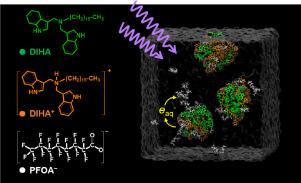Water Research ( IF 12.8 ) Pub Date : 2022-09-23 , DOI: 10.1016/j.watres.2022.119147 Xin Jin 1 , Zhe Wang 1 , Ran Hong 2 , Zhanghao Chen 1 , Bing Wu 1 , Shichao Ding 3 , Wenlei Zhu 1 , Yuehe Lin 3 , Cheng Gu 1

|
Per-/polyfluoroalkyl substances (PFASs) contamination has caused worldwide health concerns, and increased demand for effective elimination strategies. Herein, we developed a new indole derivative decorated with a hexadecane chain and a tertiary amine center (named di-indole hexadecyl ammonium, DIHA), which can form stable nanospheres (100–200 nm) in water via supramolecular assembly. As the DIHA nanospheres can induce electrostatic, hydrophobic and van der Waals interactions (all are long-ranged) that operative cooperatively, in addition to the nano-sized particles with large surface area, the DIHA nanocomposite exhibited extremely fast adsorption rates (in seconds), high adsorption capacities (0.764–0.857 g g−1) and selective adsorption for perfluorooctanoic acid (PFOA) and perfluorooctane sulfonic acid (PFOS), outperformed the previous reported high-end PFASs adsorbents. Simultaneously, the DIHA nanospheres can produce hydrated electron (eaq−) when subjected to UV irradiation, with the virtue of constraining the photo-generated eaq− and the adsorbed PFOA/PFOS molecules entirely inside the nanocomposite. As such, the UV/DIHA system exhibits extremely high degradation/defluorination efficiency for PFOA/PFOS, even under ambient conditions, especially with the advantages of low chemical dosage requirement (μM level) and robust performance against environmental variables. Therefore, it is a new attempt of using supramolecular approach to construct an indole-based nanocomposite, which can elegantly combine adsorption and degradation functions. The novel DIHA nanoemulsion system would shed light on the treatment of PFAS-contaminated wastewater.
中文翻译:

一种新开发的吲哚衍生物的超分子组装体用于全氟烷基物质的选择性吸附和光破坏
全氟/多氟烷基物质 (PFAS) 污染已引起世界范围内的健康问题,并增加了对有效消除策略的需求。在此,我们开发了一种新的吲哚衍生物,装饰有十六烷链和叔胺中心(命名为二吲哚十六烷基铵,DIHA),可通过超分子组装在水中形成稳定的纳米球(100-200 nm)。由于 DIHA 纳米球可以诱导协同作用的静电、疏水和范德华相互作用(都是长程的),除了具有大表面积的纳米颗粒外,DIHA 纳米复合材料还表现出极快的吸附速率(以秒计) , 高吸附容量 (0.764–0.857 gg -1) 和对全氟辛酸 (PFOA) 和全氟辛烷磺酸 (PFOS) 的选择性吸附,优于之前报道的高端 PFAS 吸附剂。同时,DIHA纳米球在受到紫外线照射时可以产生水合电子( e aq - ),从而限制光生的e aq -和完全吸附在纳米复合材料内的 PFOA/PFOS 分子。因此,即使在环境条件下,UV/DIHA 系统对 PFOA/PFOS 也表现出极高的降解/脱氟效率,特别是具有化学剂量要求低(μM 水平)和对环境变量具有稳健性能的优势。因此,利用超分子方法构建吲哚基纳米复合材料是一种新的尝试,它可以优雅地结合吸附和降解功能。新型 DIHA 纳米乳液系统将为 PFAS 污染废水的处理提供启示。


























 京公网安备 11010802027423号
京公网安备 11010802027423号